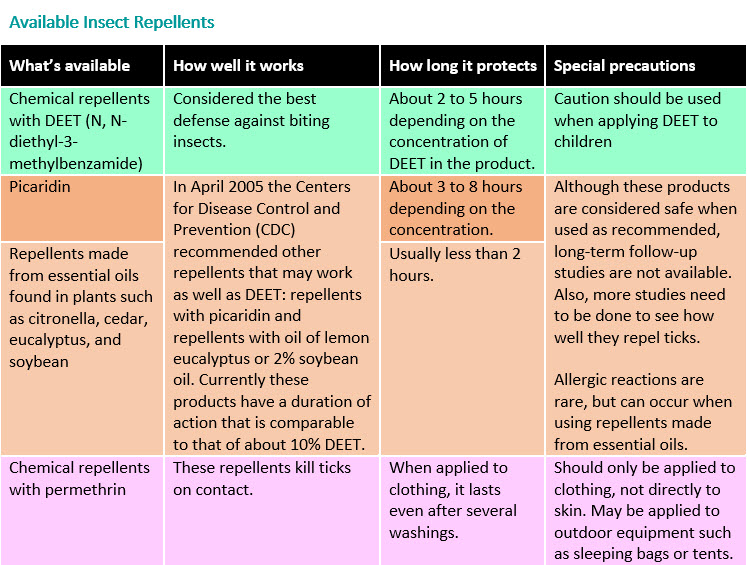Choosing an Insect Repellent for Your Child
Mosquitoes, biting flies, and tick bites can make children miserable. While most children have only mild reactions to insect bites, some children can become very sick.
One way to protect your child from biting insects is to use insect repellents. However, it’s important that insect repellents are used safely and correctly.
Types of Repellents
Insect repellents come in many forms, including aerosols, sprays, liquids, creams, and sticks. Some are made from chemicals and some have natural ingredients.

Insect repellents prevent bites from biting insects but not stinging insects. Biting insects include mosquitoes, ticks, fleas, chiggers, and biting flies. Stinging insects include bees, hornets, and wasps.
NOTE: The following types of products are not effective repellents:
- Wristbands soaked in chemical repellents
- Garlic or vitamin B1 taken by mouth
- Ultrasonic devices that give off sound waves designed to keep insects away
- Bird or bat houses
- Backyard bug zappers (Insects may actually be attracted to your yard).
About DEET
DEET is a chemical used in insect repellents. The amount of DEET in insect repellents varies from product to product, so it’s important to read the label of any product you use. The amount of DEET may range from less than 10% to more than 30%. DEET greater than 30% doesn’t offer any additional protection.
Studies show that products with higher amounts of DEET protect people longer. For example, products with amounts around 10% may repel pests for about 2 hours, while products with amounts of about 24% last an average of 5 hours. But studies also show that products with amounts of DEET greater than 30% don’t offer any extra protection.
The AAP recommends that repellents should contain no more than 30% DEET when used on children. Insect repellents also are not recommended for children younger than 2 months.
Tips for Using Repellents Safely
Dos:
- Read the label and follow all directions and precautions.
- Only apply insect repellents on the outside of your child’s clothing and on exposed skin. Note: Permethrin-containing products should not be applied to skin.
- Spray repellents in open areas to avoid breathing them in.
- Use just enough repellent to cover your child’s clothing and exposed skin. Using more doesn’t make the repellent more effective. Avoid reapplying unless needed.
- Help apply insect repellent on young children. Supervise older children when using these products.
- Wash your children’s skin with soap and water to remove any repellent when they return indoors, and wash their clothing before they wear it again.
Dont’s:
- Never apply insect repellent to children younger than 2 months.
- Never spray insect repellent directly onto your child’s face. Instead, spray a little on your hands first and then rub it on your child’s face. Avoid the eyes and mouth.
- Do not spray insect repellent on cuts, wounds, or irritated skin.
- Do not use products that combine DEET with sunscreen. The DEET may make the sun protection factor (SPF) less effective. These products can overexpose your child to DEET because the sunscreen needs to be reapplied often.
Reactions to Insect Repellents
If you suspect that your child is having a reaction, such as a rash, to an insect repellent, stop using the product and wash your child’s skin with soap and water. Then call Poison Help at 1-800-222-1222 or your child’s doctor for help. If you go to your child’s doctor’s office, take the repellent container with you.
Other Ways to Protect Your Child from Insect Bites
While you can’t prevent all insect bites, you can reduce the number your child receives by following these guidelines:
- Tell your child to avoid areas that attract flying insects, such as garbage cans, stagnant pools of water, and flowerbeds or orchards.
- Dress your child in long pants, a lightweight long-sleeved shirt, socks, and closed shoes when you know your child will be exposed to insects. A broad-brimmed hat can help to keep insects away from the face. Mosquito netting may be used over baby carriers or strollers in areas where your baby may be exposed to insects.
- Avoid dressing your child in clothing with bright colors or flowery prints because they seem to attract insects.
- Don’t use scented soaps, perfumes, or hair sprays on your child because they may attract insects.
- Keep door and window screens in good repair.
- Check your child’s skin at the end of the day if you live in an area where ticks are present and your child has been playing outdoors.
- Remember that the most effective repellent for ticks is permethrin. It should not be applied to skin but on your child’s clothing.












